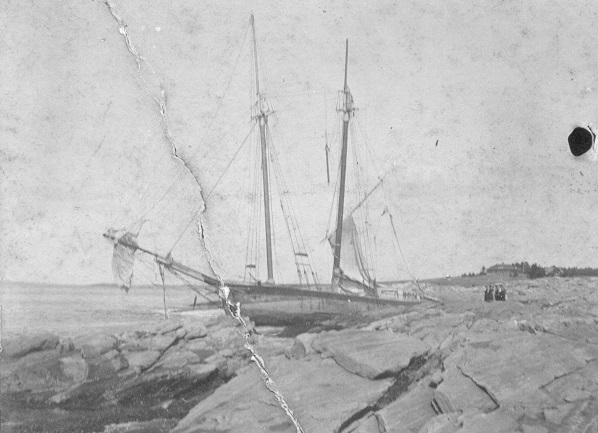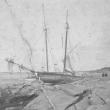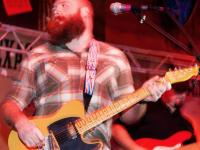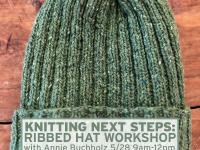In Peril on the Sea in the 1800s
 Seen here is the 81-foot schooner, William Rice, wrecked at Ocean Point late in the morning on Nov. 12, 1912 while carrying cement from Boston to Thomaston. Just before running ashore, she had sheltered from bad weather for a few days in Boothbay Harbor and departed perhaps too soon. There was no loss of life. She was declared "an old timer and not very valuable" at age 53. Vessels were expected to last 20 years. Courtesy photo
Seen here is the 81-foot schooner, William Rice, wrecked at Ocean Point late in the morning on Nov. 12, 1912 while carrying cement from Boston to Thomaston. Just before running ashore, she had sheltered from bad weather for a few days in Boothbay Harbor and departed perhaps too soon. There was no loss of life. She was declared "an old timer and not very valuable" at age 53. Vessels were expected to last 20 years. Courtesy photo
 Seen here is the 81-foot schooner, William Rice, wrecked at Ocean Point late in the morning on Nov. 12, 1912 while carrying cement from Boston to Thomaston. Just before running ashore, she had sheltered from bad weather for a few days in Boothbay Harbor and departed perhaps too soon. There was no loss of life. She was declared "an old timer and not very valuable" at age 53. Vessels were expected to last 20 years. Courtesy photo
Seen here is the 81-foot schooner, William Rice, wrecked at Ocean Point late in the morning on Nov. 12, 1912 while carrying cement from Boston to Thomaston. Just before running ashore, she had sheltered from bad weather for a few days in Boothbay Harbor and departed perhaps too soon. There was no loss of life. She was declared "an old timer and not very valuable" at age 53. Vessels were expected to last 20 years. Courtesy photo
The historical society is currently running an exhibit, "Lost at Sea," portraying, with a few chosen examples, the many seaborne hazards that resulted in lost local seafarers before 1900.
Seafaring has always been treacherous. A vigilant eye to dangers on the surrounding waters by crew members, particularly watchmen and those at the helm, could increase protection. Seamen could also lessen the odds of tragedy through maintenance. A vessel's all-natural components, including sails, lines, and the wooden hull and superstructure, needed constant upkeep and scrutiny for rot. But even tarring the lines only doubled their life from one year to two. Additionally, a vessel's metal fastenings and the necessary ironwork were all prone to corrosion. The unforgiving sea was ever watchful for a flaw—a worn link in a chain, a frayed line, a rotting plank.
Shipboard accidents
There were any number of ways for a lone man to perish at sea on a Boothbay fishing or cargo vessel in the 1800s. A man could become entangled in the coils of an anchor rope as it shot over the side; he could fall from aloft while adjusting sails, as befell Franklin L. Pinkham of the Kelley Brook area in 1860; he could fall from the deck through an open hatch into the hold, as happened to Captain John Murray of East Boothbay in 1798; or he could be struck by a mast or other gear falling from above, as was the fate of Captain John Wylie on the east side of Adams Pond in 1868.
Many men were swept overboard from the deck by a rogue or storm wave, as happened to Captain Freeman K. Reed of Boothbay Harbor in 1889. Freeman Reed had lived in the museum building, which he built for his family in 1874. At the time of his death in 1889 he was master of the three-masted Bath-built schooner, James S. Lowell, which was delivering a shipment of ice to Philadelphia. A hurricane came up off Massachusetts, washing him and another man overboard. Occasionally those washed over were washed back on the vessel, but not Captain Reed.
The Lowell, including her survivors, was in rough shape after the hurricane—her small boats washed away, no steering gear or wheel, sails carried away, and masts cut down to lessen the helpless schooner's rolling. Though they saw numerous vessels at some distance, none saw them or realized their distress. At the mercy of pounding seas for two days, the schooner began to break up. The deck beams loosened, then were washed away, and the ice stowed below all floated out and away. Finally the bark Havana rescued the seven survivors off Virginia. The abandoned wreck continued to drift for weeks, being spotted 12 times along the coast, the last sighting off Newfoundland.
Shipwreck
The Lowell's fate was all too common. Vessels and all the men aboard were threatened by storms and waterspouts, as well as by floating debris or icebergs that might stove in the hull. Storms could rip the sails, topple the masts, and disable the rudder, leaving mariners with no headway and at the mercy of winds that could drive them ashore or capsize them, drowning some or all. Equally feared was being run down by another vessel, as is thought to have happened in 1857 in the Bay of St. Lawrence to the Boothbay fishing schooner, W. F. Tarbox, killing all the men. The Boothbay fishing schooner Treaty, built by A. &. W. Adams in East Boothbay in 1842, was also run down by a large schooner near the White Islands in 1880, killing its crew. Anchored banks vessels customarily kept an ax always handy near the anchor line to cut it if an oceangoing steamship or large schooner bore down on them. This feared event is depicted in our ongoing exhibit in a haunting Morgan Rhees painting.
Dory fishing multiplied the dangers of unpredictable weather. The dories' two-man crews spent many hours away from their schooner fishing for cod at multiple nearby locations in their open boats. All that could befall schooners befell the dories—only worse. The most horrifying fate was to be engulfed by fog and unable to find the way back to the schooner, despite the schooner doing all it could to signal and guide the dories. Many men died of hunger, thirst, freezing, or drowning while searching for the safety of their vessel or any schooner while far from land near the banks.
The risks men knew
Boothbay boys went as young as seven (if big for their age like Lester Barter's uncle George Barter) to the banks. But no man or boy sailed without knowing how dangerous their time aboard might become. It was already in the mental equation, just as modern travelers have a fair idea of the figures on automobile carnage. Hard and demanding as it was to go to sea, boys and men took pride in their expertise in memorizing familiar waters and marks, predicting good fishing grounds from solid experience, landing their catch, and outwitting the menacing elements of foul weather.
Maritime author Roger Duncan wrote in Coastal Maine, the seafarer "once struck out across the sea prepared by his skill and forethought to use the vessel he was in and whatever winds came his way to move himself and his cargo to its destination. He was subject to whatever came, to gale and calm, to fog and snow and vapor. He could not predict or control it, merely take what advantage he could of it. He was on no schedule. He would arrive when and if he could. He was always in more or less peril, and he knew it."
Come see the exhibit, "Lost at Sea," at the Boothbay Region Historical Society, 72 Oak Street, Boothbay Harbor. The museum is open Thursday, Friday, and Saturday from 10 a.m. until 2 p.m. Call 633-0820 for more information.
Event Date
Address
United States






















